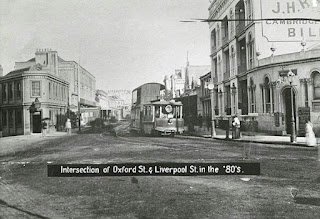Search This Blog
Sunday, March 7, 2021
Oxford Street - Darlinghurst - Sydney - New South Wales - 1788 Onwards
From The Very First Few Days After Landing At Circular Quay The Aboriginal Track Across The Top Of The Ridge Which Became Darlinghurst / Woolloomooloo Hill Has Been Used.
Thursday, June 4, 2015
Hyde Park - Sydney
HYDE PARK
A Statue Of Governor Macquarie At The Northern Most Section Of The Park Near Queens Square And St James.
Right From The Very Beginning When Governor Arthur
Phillip And The First Fleet Arrived In 1788, The Area Around The Hyde Park Area Was A Flat Scrub Land. The Tank Stream Originated From The Top Of the Area Near Hyde Park Barracks And St Marys Cathedral And Slithered Down To The Start Of George Street At Circular Quay and Emptied Into Sydney Cove In A Tidal Estuary.
The Eora Tribes That Lived Around Sydney Cove And Farm Cove Used The Area For Ceremonial Payback, And This Practice Continued Right Up Until Around 1818 When Governor Macquarie Banned It Totally From The City Area. Up Until that
Times There Was Ceremonial Payback Happening And The Convicts And The Marines Alike a Would Drink Rum And Bet On Who Would Die In These Events.
By The 1820’s The Original Tank Stream Had Just Become A Polluted Little Trickle Of Water And Whatever Waste Had Been Thrown In As Well. It Has Been Said That You Could Smell The Rocks 3 Miles Out To Sea
JOHN FRAZER
Hyde Park, located in the heart of Sydney, New South Wales, is the oldest public park in Australia and holds a rich history. It has served various purposes over the years and remains a beloved green space in the city. Here is an overview of the history and highlights of Hyde Park:
History:
Colonial Origins: Hyde Park was established in 1810, making it Sydney's oldest public park. It was originally set aside as a common area for the enjoyment of the public and was part of Governor Lachlan Macquarie's efforts to create public spaces within the city.
Name Origin: The park's name, "Hyde Park," is thought to be a nod to London's famous Hyde Park. It was named by Governor Macquarie, who had a vision of Sydney as a city with green spaces similar to those in London.
Various Uses: Over the years, Hyde Park has served various purposes. In the early 19th century, it was used for recreational activities such as horse racing, cricket, and even military drills. The park has also been the site of public gatherings and protests throughout its history.
Architectural Additions: In the mid-19th century, several architectural features were added to the park, including the Archibald Fountain (1932), which was a gift from a newspaper owner and is a popular focal point in the park. The fountain depicts figures from Greek mythology.
War Memorials: Hyde Park features several war memorials, including the Anzac War Memorial (1934-1935), which honors Australian and New Zealand soldiers who served in World War I. It is an important site for remembrance and commemoration.
Green Spaces: Hyde Park offers a respite from the bustling city, with well-maintained lawns, walkways, and mature trees. It provides a peaceful setting for picnics, leisurely strolls, and outdoor activities.
Highlights:
Archibald Fountain: The Archibald Fountain is one of Hyde Park's most iconic features. It is a beautiful and intricate fountain surrounded by a circular pond, and it serves as a gathering spot and a popular subject for photography.
Anzac War Memorial: This memorial is a significant highlight of Hyde Park. It features a striking Art Deco design and houses a museum that commemorates the sacrifices of Australian soldiers in various conflicts.
Sandringham Gardens: This section of the park features lush gardens, a pond, and a statue of King Edward VII. It's a peaceful area to relax and enjoy the scenery.
Events and Performances: Hyde Park hosts various events and performances throughout the year, including outdoor concerts, festivals, and cultural celebrations. The park comes alive during these events.
Relaxation and Recreation: Whether you're looking for a place to relax with a book, enjoy a picnic, or simply take a leisurely stroll, Hyde Park provides ample opportunities for recreation and relaxation amidst the urban environment.
Hyde Park's historical significance, beautiful landscaping, and iconic landmarks make it a cherished public space in Sydney. It continues to serve as a place for both reflection and recreation, offering residents and visitors a tranquil oasis in the heart of the city.


















































